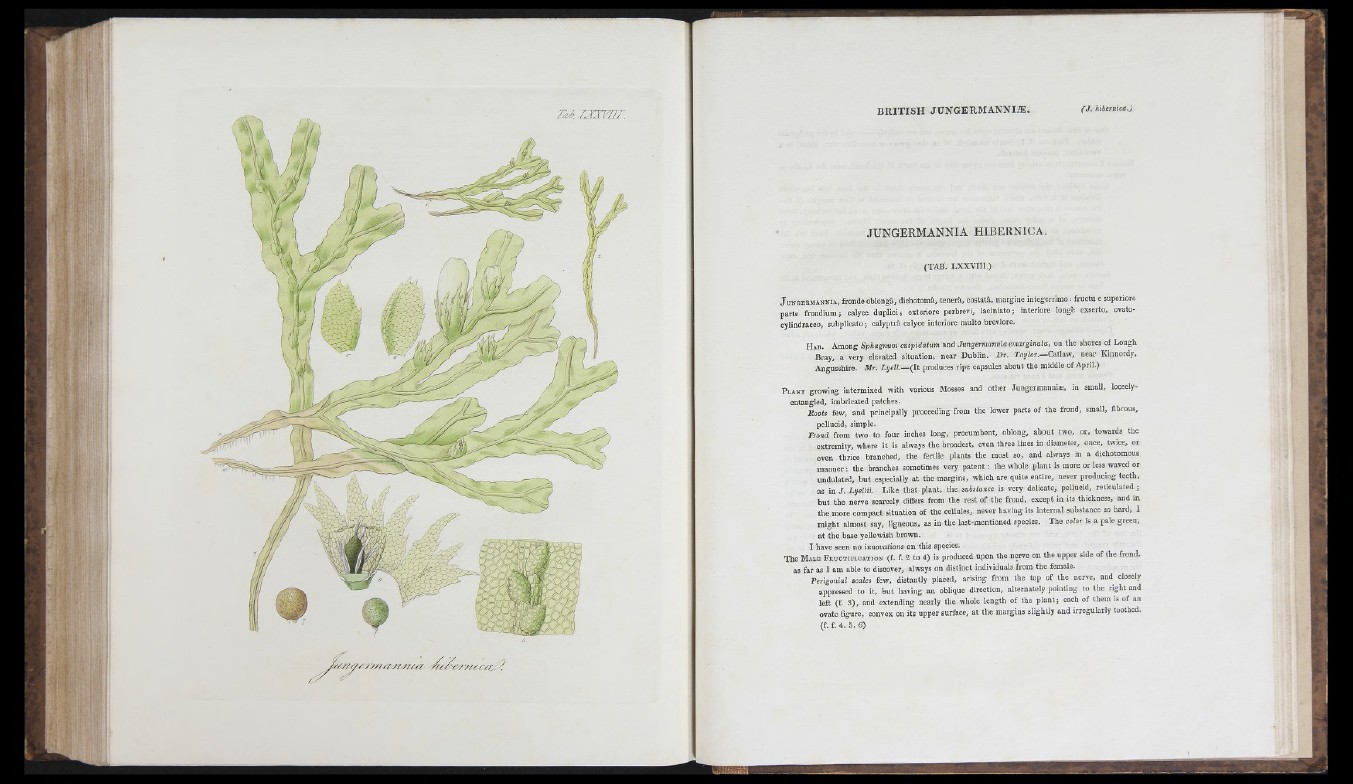
i
«r
ni
,
( u - j y i A r m a M n - n A i z
JU N G E RM A N N IA H IB E R N IC A .
(TAB. LX X V III.)
J u n g e rm a n n ia , f ro n d e o b lo n g â , d ic h o tom â , te n e r â , c o s ta tâ , m a rg in e in te g e r r im o : f r u c tu e s u p e rio re
p a r t e f r o n d i u m ; c a ly c e d u p l i c i ; e x te r io r e p e rb r e v i, la c in i a to ; in te r io re lo n g é e x s e r to , o v a to -
c y lin d r a c e o , su b p lic a to ; c a ly p tr â c a ly c e in te r io re m u lto b re v io re .
H ab . Among Sphagnum cuspidalum and Jungermannia emarginata, on th e shores o f Lough
Bray, a very elevated situa tion, ne a r Dublin. D r . Taylor.— Caüaw, ne a r Kinnordy,
Angusshire. Mr. Lyell.— { l t produces ripe capsules about th e middle o f April.)
P l a n t growing intermixed w ith various Mosses and other Junge rmanniæ, in small, loosely-
entangled, imbricated patches.
Boots few, and principally proceeding from th e lower p a rts of th e frond, small, fibrous,
pellucid, simple.
F m n i from two to four inches long, procumbent, oblong, ab o u t two, or, towards th e
extremity, where i t is always th e broadest, even three lines in diameter, once, twice, or
even th ric e branched, th e fertile plants th e most so, and always in a dichotomous
manne r ; the branches sometimes very p a ten t ; th e whole p lan t is more or less waved or
undulated, b u t especially a t th e ma rgins, which are quite entire , never producing te e th ,
as in J . LyeUii. L ik e th a t p lant, th e stibslaace is very delicate, pellucid, reticulated ;
b u t th e nerve scarcely differs from th e re s t o f th e frond, except in its thickness, and in
th e more compact situation o f th e cellules, never having its internal substance so hard, I
m ig h t almost say, ligneous, as in th e last-mentioned species. The color is a pale green,
a t th e base yellowish brown.
I have seen no innovations o n this species.
T h e M a l e F r u c t if ic a t io n (f. f. 2 to 4 ) is produced upon the nerve on th e uppe r side o f th e frond,
a s fa r as I am able to discover, always on distinct individuals from th e female.
Pei'igonial scales few, distantly placed, a rising from th e top of th e nerve, and closely
appressed to it , b u t having an oblique direction, alternately pointing to th e rig h t and
le ft (f. 3) , and extending nearly the whole len g th o f the p la n t; each o f th em is o f an
ovate figure, convex on its uppe r surface, a t th e ma rgins sUghtly and irregularly toothed,
(f. f. 4 . 5. 6)